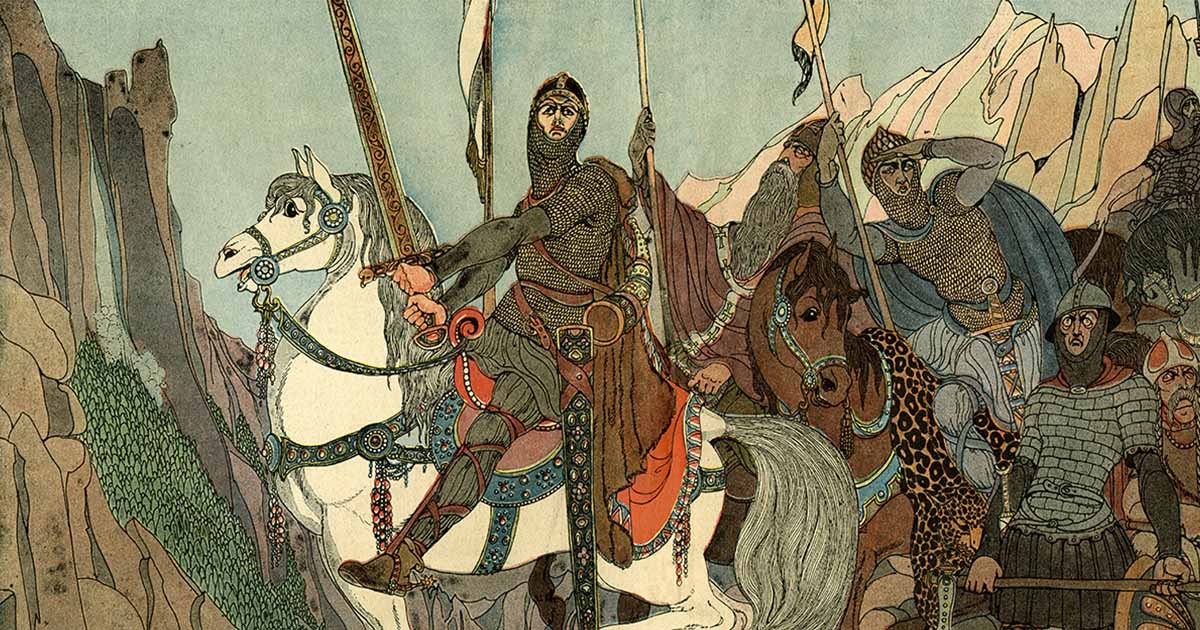Durandal: The Epic Saga of Roland's Legendary Sword
Throughout history, renowned figures and legendary heroes have been associated with mythical swords. Excalibur, linked to King Arthur of Camelot, and the Zulfiqar, believed to have been a divine gift to Prophet Muhammad, are prominent examples. Among these, Durandal, the sword of the paladin Roland, though less familiar in English-speaking regions, holds a significant place in legendary lore.

Ronald the Paladin from a 1915 book of myths. (Public domain)
Roland and his Last Stand at the Battle of Roncevaux
Although little is known about the Roland, he remains a prominent hero within medieval European folktales. In a number of legends, he is described as being the nephew of the famous Holy Roman Emperor, Charlemagne.
Roland is also considered to be the greatest of the Twelve Peers, a group of elite warriors within the court of Charlemagne. His legendary status is bolstered by his unmatched martial skills and unwavering loyalty, solidifying his place as a cherished hero in medieval European tales.
- The Heroic Story of Roland: A Valiant Knight With an Unbreakable Sword
- 15 of History’s Most Legendary Historic Swords (Video)
One of the most enduring legends surrounding Roland is his valiant last stand at the Battle of Roncevaux. This battle, rooted in historical events, took place in 778 AD during Charlemagne’s campaign in the Iberian Peninsula where Charlemagne’s Frankish army fought against the Basque forces defending their territory.
While the Battle of Roncevaux was an actual historical battle, over the centuries the stories were embellished and romanticized, adding in elements of Christian valor, heroism and chivalry which were so popular during the era. This can explain why in some versions, the Basques were joined by Saracen Muslim fighters, turning the conflict into a major battle between Christians and Muslims.
As the Frankish forces are ambushed by Basque and Saracen foes, the story recounts how Roland valiantly defended his comrades and refused to blow his horn to summon Charlemagne for reinforcements until it was almost too late. Despite being mortally wounded, Roland continued to fight bravely, only succumbing at his heroic last stand, becoming a symbol of unwavering courage and self-sacrifice in the face of overwhelming odds.

The eight phases of ‘The Song of Roland’ in one picture. (Public domain)
The Story of the Legendary Durandal Sword
The story of Roland’s heroism at the Battle of Roncevaux is most notably recounted in the epic poem La Chanson de Roland (meaning “The Song of Roland”). This epic, composed in Old French, is the earliest known source that references Durandal, a legendary sword wielded by Ronald. While the sword may have been inspired by earlier legends or myths, its primary literary reference can be found within La Chanson de Roland.
In this story, the Durandal sword was said to have been given to Charlemagne by an angel of God, who instructed the emperor to give the sword to one of his counts. Forged by the swordsmith Wayland the Smith, a mythical figure in European folklore, it was renowned for its strength and exceptional craftsmanship.
In contrast, the Italian epic Orlando Furioso (or “Orlando Enraged”) notes instead that Durandal was once the sword of the Trojan hero Hector, and was given to Roland by the enchanter Malagigi. Written by the Italian Renaissance poet Ludovico Ariosto, this tale claims that Durandal was associated with a different knight known as Orlando (a.k.a. Ronald), who experiences a bout of madness brought about by unrequited love and becomes convinced he needs to destroy Durandal to prove his loyalty to his love.
Regardless of its origins, the Durandal sword was both valuable and powerful. In fact, in Orlando Furioso, the primary objective of invasion of France by Gradasso, the heathen king of Sericena, is said to be the retrieval of Durandal from Roland.
The Durandal Sword within Ancient Legend
With Durandal, it was said that Roland had accomplished many great feats for Charlemagne. This is evidenced within the text of the epic poem Orlando Furioso;
“I won for him with thee Anjou, Bretaigne, / And won for him with thee Peitou, the Maine, / And Normandy the free for him I gained, / Also with thee Provence and Equitaigne, / And Lumbardie and all the whole Romaigne, / I won Baivere, all Flanders in the plain, / Also Burguigne and all the whole Puillane, / Costentinnople, that homage to him pays; / In Saisonie all is as he ordains; / With thee I won him Scotland, Ireland, Wales, / England also, where he his chamber makes; / Won I with thee so many countries strange / That Charles holds, whose beard is white with age!”
At Roncevaux, Roland was allegedly able to hold back the Muslim army, which was a 100,000 strong, from attacking Charlemagne’s main force. Using Durandal, Roland was said to have slayed many enemies, and even succeeding in chopping off the right hand of the Saracen king Marsile and decapitating the king’s son Jursaleu.

Left: Painting depicting La Brèche de Roland and Ronald blowing the horn at the Battle of Roncevaux. (Carl von Bibra / CC BY-SA 4.0) Right: Modern-day photo of La Brèche de Roland. (Jens Buurgaard Nielsen / CC BY-SA 3.0)
Why Was the Durandal Sword So Special?
One of the significant features of Durandal is that it contained a number of sacred Christian relics. In La Chanson de Roland, it is written that “Relics enough thy golden hilt conceals: / Saint Peter's Tooth, the Blood of Saint Basile, / Some of the Hairs of my Lord, Saint Denise, / Some of the Robe, was worn by Saint Mary.”
La Chanson de Roland also depicted Durandal as an indestructible weapon. When all was lost at Roncevaux, Roland attempted to destroy Durandal in order to prevent it from falling into the hands of the enemy. In a final act of strength and determination, he attempted to destroy the sword by striking a massive rock with it, but his efforts were to no avail; “Rollant his stroke on a dark stone repeats, / And more of it breaks off than I can speak. / The sword cries out, yet breaks not in the least, / Back from the blow into the air it leaps.”
According to legend, Roland’s failed endeavor to destroy Durandal created the La Brèche de Roland, a natural gap measuring 40 meters (131 ft) across and 100 meters (328 ft) high in the Pyrenees. While the specific details and attributions may vary between different versions of the legend, La Brèche de Roland remains a popular and enduring element of the Roland stories, and it is an actual geographical feature in the Pyrenees, further adding to its mystique.

The alleged Durandal sword at the Chapelle de Notre-Dame in Rocamadour. (Patrick Clenet / CC BY-SA 3.0)
As Roland failed to destroy Durandal, he decided to hide it beneath his body before he died. In another account, Roland flung Durandal into the air, where it magically landed embedded in a rock in Rocamadour, a pilgrimage site about 160 km (99 mi) to the north of Toulouse.
Curiously, visitors to the Chapelle de Notre-Dame in Rocamadour can see an iron sword wedged in the rock above the door leading to the chapel. Some believe that this was the actual sword belonging to Roland. It has even been bound with a chain so as to prevent anyone from stealing it.
Top image: Roland at the Battle of Roncevaux holding the legendary Durandal sword. Source: Archivist / Adobe Stock
By Wu Mingren
References
Anon. [Trans. Moncreiff, C.K.] 1919. The Song of Roland. Available at: http://www.gutenberg.org/cache/epub/391/pg391.txt
Ariosto, L., [Trans. Rose, W. S.] 1996. Orlando Furioso. Available at: http://www.gutenberg.org/cache/epub/615/pg615.txt
Caro, I., 2002. “The Arch of Orange” in J. O'Reilly & L. H. S. O'Reilly (eds.) Traveler's Tales France: True Stories. San Francisco: Traveler's Tales Inc., pp. 99-107.
Joe, J. 2006. “Twelve Peers” in Timeless Myths. Available at: http://www.timelessmyths.com/arthurian/peers.html


















Comments
Even with its feats and relics, the mightier weapon at Roland's disposal was his olifant, the Song of Roland stresses that had he blown his horn, Roland might have saved his army
Perhaps of most accurate translation of "Le Chanson de Roland" from ancient French to English was by Dr. Thomas A. Jenkins (University of Chicago) in the early 20th century.
Interesting. I wonder what the carbon dating on the sword would come to